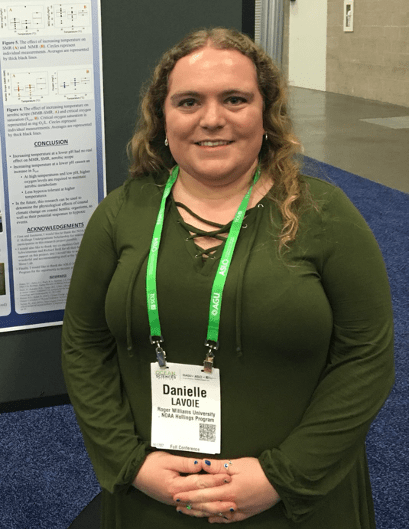Written & Edited by Rachel Pichette
Posted by Ricardo Serrano
While we might seem disconnected during this pandemic, UMass Dartmouth is still very much a community. Our students are still doing great work that we think should be shared. This week we will be spotlighting the fascinating work of one of our graduate students in the Marine Biology program, Danielle Lavoie.
Lavoie is from Willington, Connecticut, and graduated from Roger Williams University in 2018 with a Bachelor of Science in Marine Biology before pursuing her master’s degree here at UMass Dartmouth.
Lavoie’s thesis research focuses on American eels and the impact of a parasite known as Anguillicola Crassus, on the species. The parasite infects the swimbladder, an organ that helps American eels float. Not much is known about the impact of environmental conditions on the parasite’s life cycle. Lavoie says “The first part of my thesis involves researching the effect of low temperatures on the survival of the free-living life stage of the parasite to determine if it can survive over winter in the St. Lawrence River area.”

Eels spend most of their lives living on river bottoms, however, once they reach maturity, they migrate to the Sargasso Sea to reproduce. There is evidence to suggest that this parasite makes migration more difficult for the eels because of their impact on the swimbladder. This can prevent eels from making it to their spawning grounds and hinder reproduction. “The eel population has declined drastically since the 1980s, so if this parasite does detrimentally affect this migration, that’s bad news for the population,” Lavoie explains.

The diagram above shows the lifecycle of the parasite, Anguillicola crassus.
While most people may not think about eels often, they are an important species not only for biodiversity but also for commercial reasons. Lavoie explains, “Ecologically, American eels are an important prey species for larger fish, birds, and even mammals. Commercially, there’s an important fishery for American eels, which are then used as bait for striped bass. Some people will also fish for them recreationally to then use as bait. Young glass eels are extremely valuable because they are sent to Asia for eel aquaculture, so there is a highly regulated fishery that brings in a lot of money. Since the 1980s, the eel population has declined dramatically, mostly due to the building of dams that cut off large parts of their native range.”
Lavoie’s interest in marine life and the ocean environment brought her to this particular area of study. “I was really excited to get to work on a project that looked at the interaction between eels, a parasite, and the environment. Eels are a species in decline, so learning more about this invasive parasite can help scientists make management decisions,” she says.
Lavoie has also developed an important method of screening for these parasites that can be conducted without harming the eel. The non-lethal screening uses a digital dental X-ray on the swim bladder to detect the parasites. Lavoie says “Parasitic infections show up as light shadows within the dark shape of the swim bladder, and they can be easily taken while the eel is under anesthetic rather than dissecting the eel.” This screening method has also enabled the final part of her research. Lavoie is also attempting to artificially infect eels with the parasites in order to track their growth.
When asked about the challenges that come with this process, Lavoie said, “Working with live animals means they don’t always cooperate with you. And my artificial infection experiments have proven to be a really challenging part of my research.”
Lavoie hopes to eventually publish her work in an academic journal. After graduation, she plans to work in a state or federal fisheries capacity. “I want to do research that helps to regulate and conserve important species.” She says.
This is Lavoie’s third year in the program and she is set to graduate this spring in 2021. When she isn’t studying eels or conducting important research she enjoys reading, cooking, baking, and snuggling with her dog.
You can follow her on Twitter at @DRLavoie52
